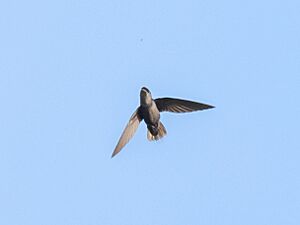Chapman's swift facts for kids
Quick facts for kids Chapman's swift |
|
|---|---|
 |
|
| Conservation status | |
| Scientific classification | |
| Genus: |
Chaetura
|
| Species: |
chapmani
|
 |
|
| Synonyms | |
|
Chaetura viridipennis |
|
The Chapman's swift (Chaetura chapmani) is a small, fast-flying bird that belongs to the swift family. These birds are known for their amazing flying skills. They spend most of their lives in the air. You can find Chapman's swifts in many countries across South America, including Brazil, Colombia, and Venezuela. They also live on the island of Trinidad.
Contents
About Chapman's Swifts
How Scientists Name Birds
Scientists use a system called taxonomy to name and group living things. The Chapman's swift has two main types, called subspecies. They are C. c. chapmani and C. c. viridipennis. For a while, some scientists thought viridipennis was a completely different species. But now, they agree it is a subspecies of the Chapman's swift.
Long ago, the Chapman's swift, the chimney swift, and Vaux's swift were all thought to be the same species. But now we know they are different.
Who Was Frank M. Chapman?
The Chapman's swift is named after a famous bird expert, Frank M. Chapman. He studied birds in South America.
What Does a Chapman's Swift Look Like?
Chapman's swifts are about 13 to 14 centimeters (5 to 5.5 inches) long. They weigh about 21 to 28 grams (less than an ounce). That's about the weight of a few quarters!
They have a head that sticks out and a short, square tail. Their wings are special because they look a bit bent in the middle. Both male and female Chapman's swifts look alike.
Colors of Their Feathers
The main type of Chapman's swift has shiny black feathers on its back and top. Its lower back and upper tail feathers are dark gray. The feathers on its belly and chest are dark brown.
The other type, C. c. viridipennis, is a bit larger. Its feathers are mostly the same. But its gray lower back blends more smoothly with its black back.
Where Do Chapman's Swifts Live?
Their Homes Across South America
The main type of Chapman's swift lives in Panama, western and northern Colombia, and northwestern Venezuela. You can also find them in eastern Venezuela, the Guianas (like French Guiana and Guyana), and northeastern Brazil. They also live on the island of Trinidad.
The C. c. viridipennis subspecies lives in eastern Peru, eastern Bolivia, and western Amazonian Brazil. Some people have seen them in Ecuador, but scientists are still checking if they truly live there.
What Kind of Places Do They Like?
Chapman's swifts mostly live in tropical lowland evergreen forests. These are forests where trees stay green all year. They also live in secondary forests, which are forests that have grown back after being cut down. They can also be found in scrublands.
Sometimes, they fly and eat over coastal swamps and areas with mangrove trees. In Colombia, they live from sea level up to about 1,600 meters (5,200 feet) high. In other areas, they live at lower elevations, usually below 800 meters (2,600 feet).
How Do Chapman's Swifts Behave?
Do They Migrate?
The main type of Chapman's swift stays in the same place all year round. They do not migrate.
However, the C. c. viridipennis subspecies does move. After their breeding season, they leave Bolivia and parts of Peru and western Brazil. They seem to move further east in Brazil.
What Do They Eat?
Like all swifts, Chapman's swifts are aerial insectivores. This means they catch and eat insects while flying! They often fly and hunt for food with other swift species. But sometimes, you can see them flying in groups only with other Chapman's swifts.
How Do They Raise Their Young?
The main type of Chapman's swift builds nests during the wet season, from late spring to early autumn. The C. c. viridipennis subspecies seems to nest during the summer in the southern part of the world.
Not many of their nests have been found. They build a half-cup-shaped nest that they stick to a vertical surface. This is often a human-made structure, like inside a chimney. Some people think they might also nest inside hollow trees.
A female swift usually lays two or three eggs. The eggs hatch after about 17 to 18 days.
What Sounds Do They Make?
The main call of a Chapman's swift is a long series of sharp, single notes. It sounds like "tseep..tseep..tseep." They usually do not make chirping or trilling sounds. They also make shorter "tsip" calls.
Conservation Status
Are They Endangered?
The IUCN (International Union for Conservation of Nature) has looked at the Chapman's swift. They have listed it as a species of "Least Concern." This means they are not currently in danger of disappearing.
Chapman's swifts live in a very large area. Scientists estimate there are at least 50,000 adult birds. However, this number is thought to be slowly going down. Even so, no immediate threats have been found that would put them in danger.
It is one of the rarer swifts in South America. Scientists do not have many samples or observations of them. Because of this, the exact places where they breed are not fully known.


